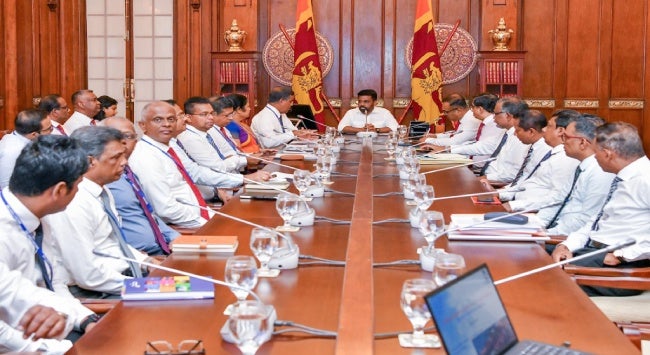Summary
Sri Lanka’s 2025 budget reflects an attempt at a difficult balancing act between adhering to the condition of the ongoing International Monetary Fund programme and an election mandate of supporting inclusive and equitable economic growth.
Sri Lanka’s national budget for 2025, presented by President Anura Kumara Dissanayake, is the first under the National People’s Power (NPP) government, which came to power in November 2024. The budget is shaped by the ongoing International Monetary Fund (IMF) programme, which Sri Lanka joined in 2023, imposing significant constraints on the government’s fiscal plans. Meeting IMF targets is crucial to improve Sri Lanka’s credit rating and regaining access to international financial markets for borrowing and debt repayment starting in 2028. Within these limitations, the budget largely maintains austerity measures from previous years, highlighting the government’s struggle to balance equitable economic recovery with the need for macroeconomic stability and growth.
Meeting the Revenue Gap
The government aims to increase tax revenue to LKR1.9 trillion (S$ 8.58 billion), a significant rise from LKR1 trillion (S$ 4.51 billion) in 2019. To this end, the budget speech outlines several key revenue proposals, including the introduction of an 18 per cent value-added tax (VAT) on digital services, the removal of Special VAT, increasing the withholding tax rate from 5 to 10 per cent (with exemptions for lower income groups), and an increase in the capital gains tax from 10 per cent to 15 per cent.
The budget also includes proposals to expand exports, reduce tariffs and establish a centralised digital platform that enables traders to submit all trade-related documents electronically through a single entry point. These initiatives are aimed at improving trade efficiency and are geared at attracting foreign direct investment.
Revenue targets have frequently faced challenges in administration, with the tax system often criticised for its complexity due to a multiplicity of taxes and the limited institutional capacity to manage them. As a result, previous governments have struggled to meet tax collection goals.
The current budget aims to address these issues by leveraging technology. It focuses on digitisation and administrative reforms to modernise systems and improve efficiency. Key measures include mandating point-of-sale systems to enhance tax collection and reduce evasion, as well as implementing databases for land management to streamline property transactions and improve the accuracy of land records.
The Future of the Public Sector?
Sri Lanka has a large public sector that employs over 14 per cent of the workforce, including a significant military sector, a legacy of the war era. Although the IMF programme has recommended downsizing Sri Lanka’s public sector, recent salary revisions have been driven by the rising cost of living, particularly since the economic crisis. In February 2025, the Cabinet of Ministers approved the recruitment of nearly 7,500 individuals to various government institutions, based on the recommendations of a committee appointed to review recruitment and staff management in the public service. While the committee endorsed filling these positions, it also proposed repurposing existing overstaffed sections within the public service to accommodate the new roles.
The budget proposals include a phased increase in public sector salaries, with a total allocation of LKR110 billion (S$497 million) for this purpose in the 2025 budget. Increasing public sector salaries was a key campaign promise of the NPP government and presidency. Additionally, the budget provides for a three per cent increase in military spending, raising the allocation to LKR442 billion (S$1.996 billion). Dissanayake, in his role as Minister of Defence, also reaffirmed his government’s commitment to the previous administration’s decision to reduce troop numbers. Notably, the budget also allocates LKR20 billion (S$90.3 million) to repay old debt and interest related to the state-owned national carrier, Sri Lankan Airlines. While the previous government of Ranil Wickremesinghe had initiated a privatisation process for the airline, the new government reversed this decision, highlighting the airline’s importance for the country’s tourism sector.
Meeting the Popular Mandate
The NPP’s election campaigns promised to strengthen the social security sectors, particularly health and education. The 2022 crisis, coupled with the long-standing decline of the social security sector, significantly impacted the quality of public education and healthcare.
The 2025 budget allocates LKR232.5 billion (S$1.05 billion) for Aswesuma, the official safety net programme, an increase aimed at addressing these challenges. The budget also allots LKR479 billion (S$2.16 billion) to the health sector, reflecting an increase of LKR43 billion (S$194.1 million) compared to the revised 2024 estimates. Similarly, a sum of LKR285 billion (S$1.29 billion) has been earmarked for education and research in the 2025 budget. This reflects an increase of LKR17 billion (S$76.7 million) over the revised budget estimates for 2024. However, while nominal expenditure on education and health has witness an increase, there were no substantial increases in these sectors as a percentage of gross domestic product.
Sri Lanka’s 2025 budget reflects the government’s attempt to balance meeting IMF targets with fulfilling its mandate of equity and sustainable growth. The budget sets ambitious targets to deliver on this broad mandate although the detailed implementation of these proposals remains to be seen. The economic discontent and anti-establishment sentiment that helped propel this government to power now present a complex challenge, as it must navigate the tension between addressing these aspirations and the fiscal realities of governance.
. . . . .
Dr Rajni Gamage is a Research Fellow at the Institute of South Asian Studies (ISAS), an autonomous research institute at the National University of Singapore (NUS). She can be contacted at r.gamage@nus.edu.sg. The author bears full responsibility for the facts cited and opinions expressed in this paper.
Pic credit: X
-
 More From :
More From :
-
 Tags :
Tags :
-
 Download PDF
Download PDF



